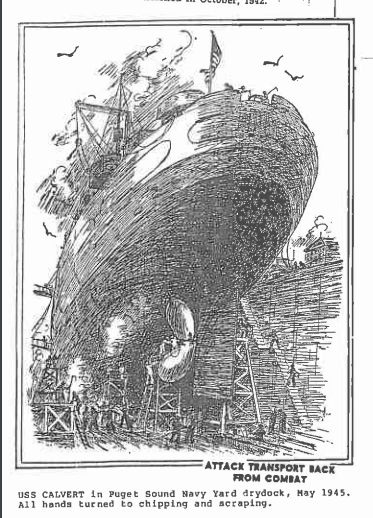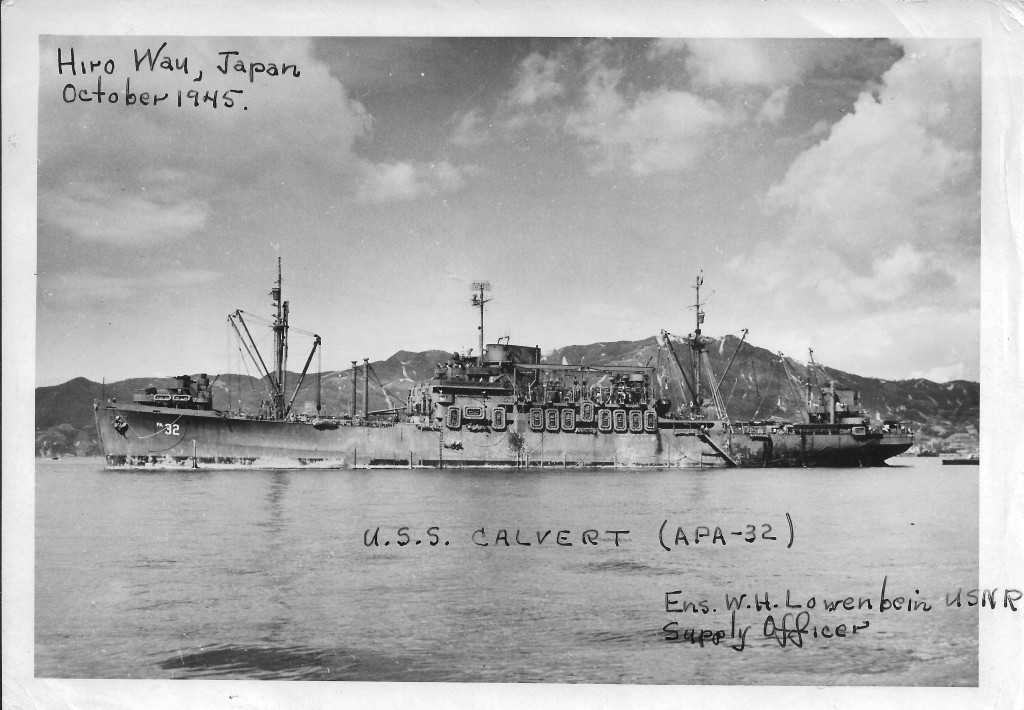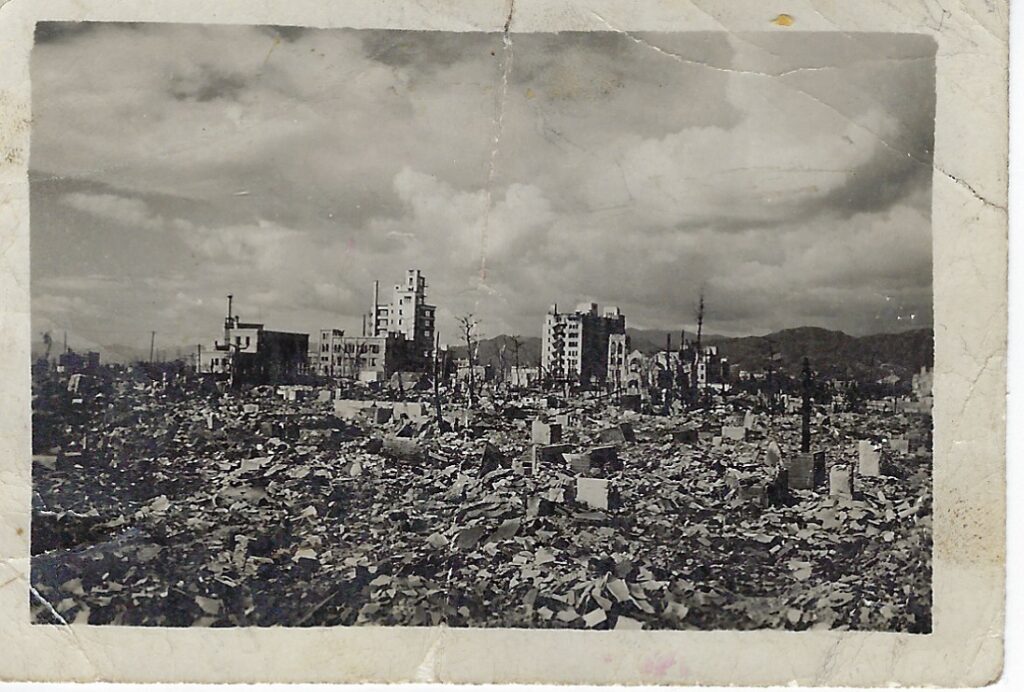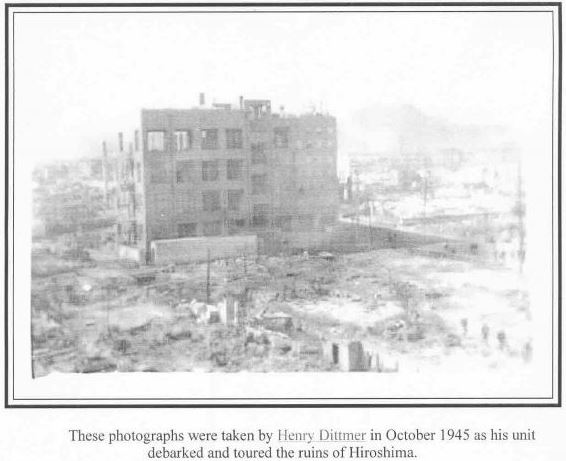In early March 1945 the USS Calvert sailed from Ulithi Atoll, West Carline Group, to Hawaii and then to Bremerton Washington with orders to undergo conversion to a Relief ACG, Amphibious Force Flagship, for the planned invasion of the Japanese islands.
“Upon it’s arrival on 26 March 1945 at Seattle, a yard availability period was utilized to convert this vessel into a Relief ACG (RAGC). … tending to change her general characteristics from a conventional attack transport to an attack transport equipped to operate as a relief ACG-Amphibious Force Flagship. This entailed the installation of additional communication, plotting, gunnery, detection and administrative facilities, plus administrative and berthing facilities for embarked naval and troop staffs. During this period the original troop carrying capacity, and cargo capacity of the Calvert were reduced.” from David B. Cullen’s History of the USS Calvert

As a Relief ACG, the Calvert was fitted and capable for the dual purposes of serving as the flagship for an amphibious operation and land troops and equipment in support of the operation. As flagship, the squadron commander directed and coordinated the overall operation aboard ship.
The conversion began in late-March and ended in mid-August. The Japanese had surrendered a few days before the Calvert’s conversion work was completed.
With the war over, the Calvert was ordered to participate in the occupation of Japan.
On October 1, 1945 the Calvert in company with the Central Occupation Force entered the Hiro Wan waters near Hiroshima, Japan. From October 1st to November 1st the Calvert remained in the Hiro Wan inland waters area near Hiroshima, Japan. Landing of the occupational force for this region of Japan was made at Matsuyama, Shikoku (across the bay from Hiroshima) on October 22nd.

During this time in Hiro Wan Bay many of the crew visited the city of Hiroshima. Appreciation to RM3 Robert Randle’s sister, Maureen, for providing a copy of this photograph Robert took while in Hiroshima.

And appreciation to David Dittmer, son of PhM3c(T) Henry Dittmer, for sharing this photo, among several items of interest regarding the Calvert’s participation in the occupation of Hiroshima. “Towards the end of the war after the bomb was dropped on Hiroshima, his ship was sent to Japan. He and a pilot were dispatched on a small boat with a couple of officers to Hiroshima.”

Here are a additional memories shared by crew members who were ashore in Hiroshima at this time:
1) “There were no occupational forces in the city only specialty people. We spent approximately 3 or 4 hours walking through the ruins and observing the devastation.” – Calversion, Vol 6, p9 – C. G. Clauss
2) “Earl often spoke of his time aboard the USS Calvert and told of being the Captain’s orderly and said that that he and several others went ashore (Hiroshima) with the Captain to see the ruins.” – Calversion, Vol 5, p8 – Charloette M. Hammond, wife of Earl S. White, S1c, USNR
3) “We took liberty boats to Hiroshima. It was a mess – of course we had to look for a beer which we found after a wild ride in an old pick-up truck we flagged down.” – Calversion, Vol 26, P6- Darrel “Bud” Gerard
4) “I can recall the land,” said Loehr, now mayor of St. Cloud, “all turned over, just as though it was freshly plowed. Awfully barren. Some structures were still standing, but most weren’t. I was just a young man in the Navy, 18 years old, and I was really kind of set back by the devastating damage I’d seen.” – Star Tribune, Minneapolis, MN. August 31, 1975.
5) “We were anchored about seven miles from Hiroshima so out of curiosity a group of us took one of our landing crafts over to see it,” Shaddock remembers. “I believe we were some of the first Americans to see what it looked like after the dropping of the bomb. It was just miles and miles of utter destruction. We found stacks of dishes that had been fused together by the heat of the bomb, and gravel that had been fused to a porcelain pitcher.” – Warren Shaddock- Pulteney Street Survey. Winter 2016. p1. Hobart and William Smith Colleges.
6) “We went ashore only two days in Hiroshima. I was in the Medical Corp. There was, I think, two of us Medics went in, with the rest of the groups, I was in the amphibious group 11. … The place was still a mess, just flattened out.” Visit this page for additional interview commentary from Henry Dittmer, who was a PhM3c(T) aboard the Calvert at this time.
7) Amazed at Sights on Hiroshima: P.G. Potiriades, PhM3 3/c, found a number of things on Hiroshima, Japan, that rather amazed him, according to a letter received from him here. “It’s hard to imagine how one bomb could completely destroy a city the size of St. Paul or Minneapolis in one or two seconds.” he wrote after having stood in the midst of the city. “In an area of 15 blocks in every direction nothing could be seen standing over a foot tall. In fact, it was very difficult to find anything larger than your fist in one single piece.” He had gone through a temporary hospital and was shocked at the lack of sanitation in the laboratories. They were all furnished with German books, guides and equipment, he said. “What impressed me the most was that as soon as anyone was old enough to walk he was wearing an army uniform. Boys, 2, 3 and 4 years old were all in uniform – but just try to bargain for any of it. I imagine that it’s all the clothing that they have, however, I haven’t seen any 2 uniforms the exact kind.” Potriades was having liberty from his ship, the USS Calvert, when he made his observations. – Globe-Gazette. Mason City, Iowa. November 26, 1945
8) “… Government agencies and the Veterans Administration contend the Calvert was anchored 10.9 miles from the city of Hiroshima. The assumption is of course that the men were never any closer to Hiroshima than 10 miles. This is not true because they went ashore in the ship’s landing boats. … In the days we were in the area there were several day long trips by the ships landing boats to Hiroshima enabling the crew to spend many hours walking around among the ruins and in the streets of Hiroshima. They took a lot of pictures and I am sure they are available as evidence of their presence there. … A little background on this — the USS Calvert was the Flagship for the occupation of Southern Honshu, which included the Kure Naval Base, Hiro Prefecture, the city of Matsuyama, (where the first occupation landing took place) and Hiroshima. The Japanese Admiral and his staff came aboard to meet with our Admiral (I believe it was Admiral Rodgers), and clear the way for the occupation. The date was October 5, 1945. At that time no naval personnel had been to Hiroshima and there was some question as to how they would be received, considering the battering the city had taken. The first group to enter Hirososhima were the men from the Calvert as a test mission — orders were no guns, no hostile attitude or action — just candy, cigarettes, soap, etc. to give out to show the people and children that they were not going to be treated badly. The only precaution was not to go wandering around alone and to stay in groups of 5 or more. There were no warnings about possible residual radation. I was on the first trip. I recall it was Columnus Day, October 12, 1945 and there were about a dozen officers and I think 48 enlisted men. By the time we left the area most of the crew of the USS Calvert had been in Hiroshima.” – Calversion, Vol 40, pp2, 3 – Leroy Steiner, Lt. USNR
Additional photographs of the September and October timeframe are available on page 5 of volume 33 of the Calversion.
The Calvert departed Hiro Wan on November 2nd, sailing to Yokosuka, Japan. On November 7th she sailed for Pearl Harbor and then returned to the West Coast of the United States. From there the Calvert participated in Operation Magic Carpet by transporting U.S. military personnel and equipment from the Pacific to the West Coast of the U.S.
This is a fascinating account of a horrendous, but probably necessay, point in history. Amazing there was no concern about residual radiation.
Hi Mr. McCurrach, yes this was a difficult topic for me to figure out how to present on the web site. So I kept it as factual as possible based on historical record and direct quotes from the men who were there. It is surprising to think that there was little regard for exposure to residual radiation.
Chris